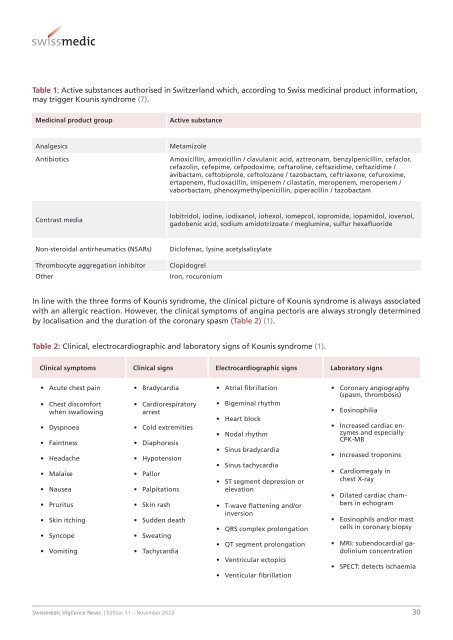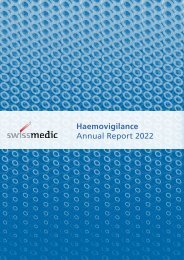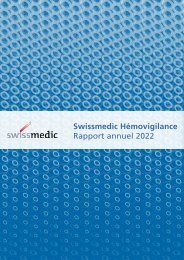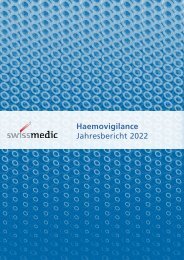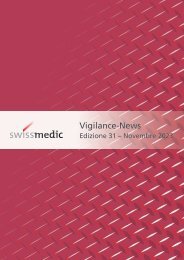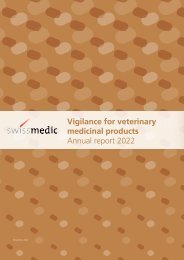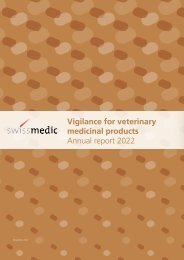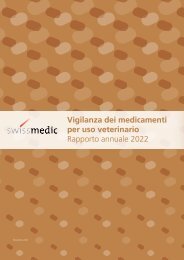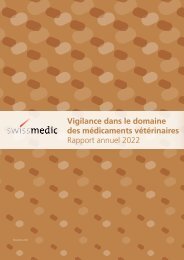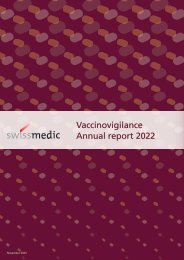Swissmedic Vigilance News
Edition 31 – November 2023
Edition 31 – November 2023
You also want an ePaper? Increase the reach of your titles
YUMPU automatically turns print PDFs into web optimized ePapers that Google loves.
Table 1: Active substances authorised in Switzerland which, according to Swiss medicinal product information,<br />
may trigger Kounis syndrome (7).<br />
Medicinal product group<br />
Active substance<br />
Analgesics<br />
Antibiotics<br />
Metamizole<br />
Amoxicillin, amoxicillin / clavulanic acid, aztreonam, benzylpenicillin, cefaclor,<br />
cefazolin, cefepime, cefpodoxime, ceftaroline, ceftazidime, ceftazidime /<br />
avibactam, ceftobiprole, ceftolozane / tazobactam, ceftriaxone, cefuroxime,<br />
ertapenem, flucloxacillin, imipenem / cilastatin, meropenem, meropenem /<br />
vaborbactam, phenoxymethylpenicillin, piperacillin / tazobactam<br />
Contrast media<br />
Iobitridol, iodine, iodixanol, iohexol, iomeprol, iopromide, iopamidol, ioversol,<br />
gadobenic acid, sodium amidotrizoate / meglumine, sulfur hexafluoride<br />
Non-steroidal antirheumatics (NSARs)<br />
Thrombocyte aggregation inhibitor<br />
Other<br />
Diclofenac, lysine acetylsalicylate<br />
Clopidogrel<br />
Iron, rocuronium<br />
In line with the three forms of Kounis syndrome, the clinical picture of Kounis syndrome is always associated<br />
with an allergic reaction. However, the clinical symptoms of angina pectoris are always strongly determined<br />
by localisation and the duration of the coronary spasm (Table 2) (1).<br />
Table 2: Clinical, electrocardiographic and laboratory signs of Kounis syndrome (1).<br />
Clinical symptoms Clinical signs Electrocardiographic signs Laboratory signs<br />
• Acute chest pain<br />
• Chest discomfort<br />
when swallowing<br />
• Dyspnoea<br />
• Faintness<br />
• Headache<br />
• Malaise<br />
• Nausea<br />
• Pruritus<br />
• Skin itching<br />
• Syncope<br />
• Vomiting<br />
• Bradycardia<br />
• Cardiorespiratory<br />
arrest<br />
• Cold extremities<br />
• Diaphoresis<br />
• Hypotension<br />
• Pallor<br />
• Palpitations<br />
• Skin rash<br />
• Sudden death<br />
• Sweating<br />
• Tachycardia<br />
• Atrial fibrillation<br />
• Bigeminal rhythm<br />
• Heart block<br />
• Nodal rhythm<br />
• Sinus bradycardia<br />
• Sinus tachycardia<br />
• ST segment depression or<br />
elevation<br />
• T-wave flattening and/or<br />
inversion<br />
• QRS complex prolongation<br />
• QT segment prolongation<br />
• Ventricular ectopics<br />
• Venticular fibrillation<br />
• Coronary angiography<br />
(spasm, thrombosis)<br />
• Eosinophilia<br />
• Increased cardiac enzymes<br />
and especially<br />
CPK-MB<br />
• Increased troponins<br />
• Cardiomegaly in<br />
chest X-ray<br />
• Dilated cardiac chambers<br />
in echogram<br />
• Eosinophils and/or mast<br />
cells in coronary biopsy<br />
• MRI: subendocardial gadolinium<br />
concentration<br />
• SPECT: detects ischaemia<br />
<strong>Swissmedic</strong> <strong>Vigilance</strong> <strong>News</strong> | Edition 31 – November 2023<br />
30


